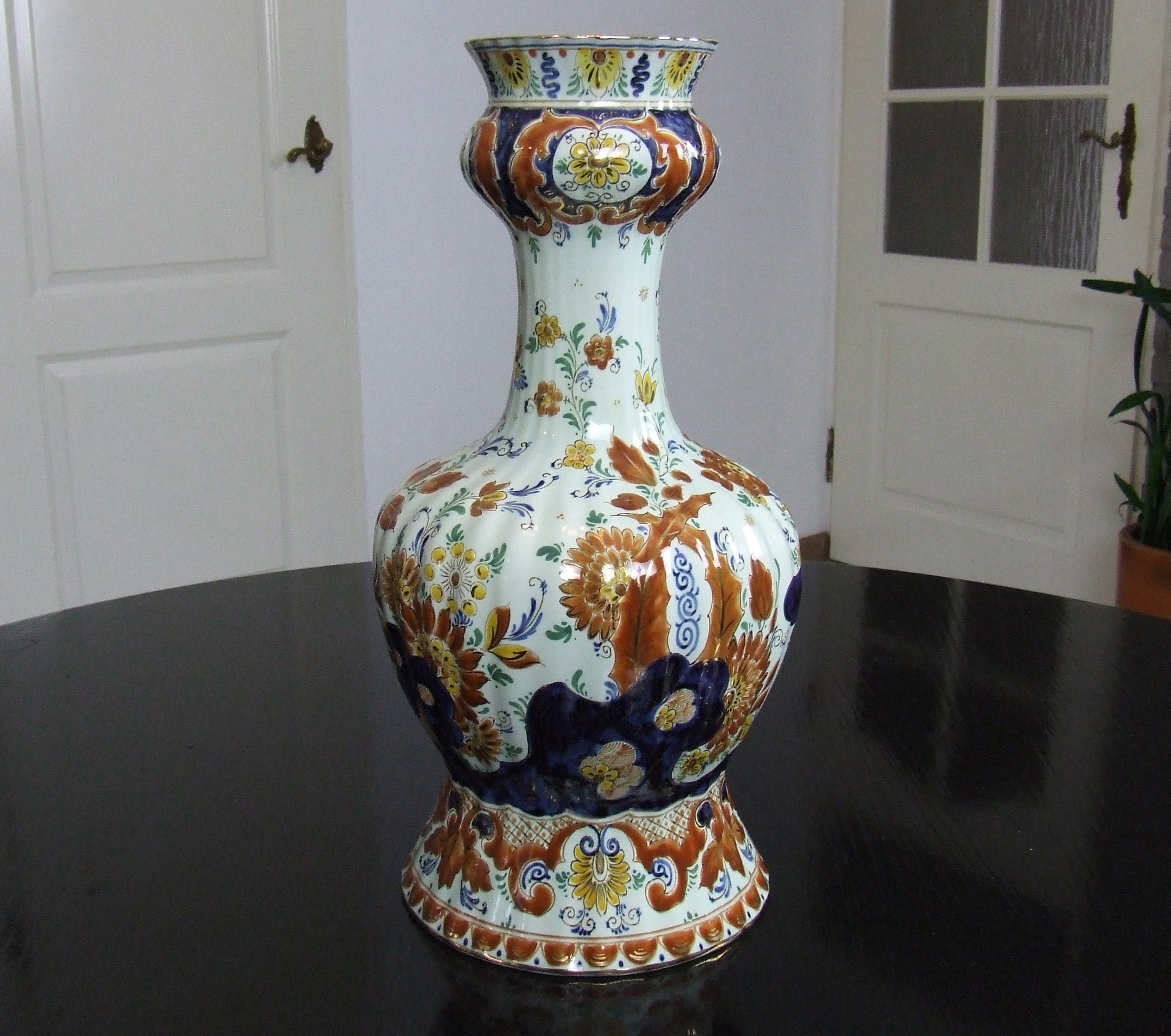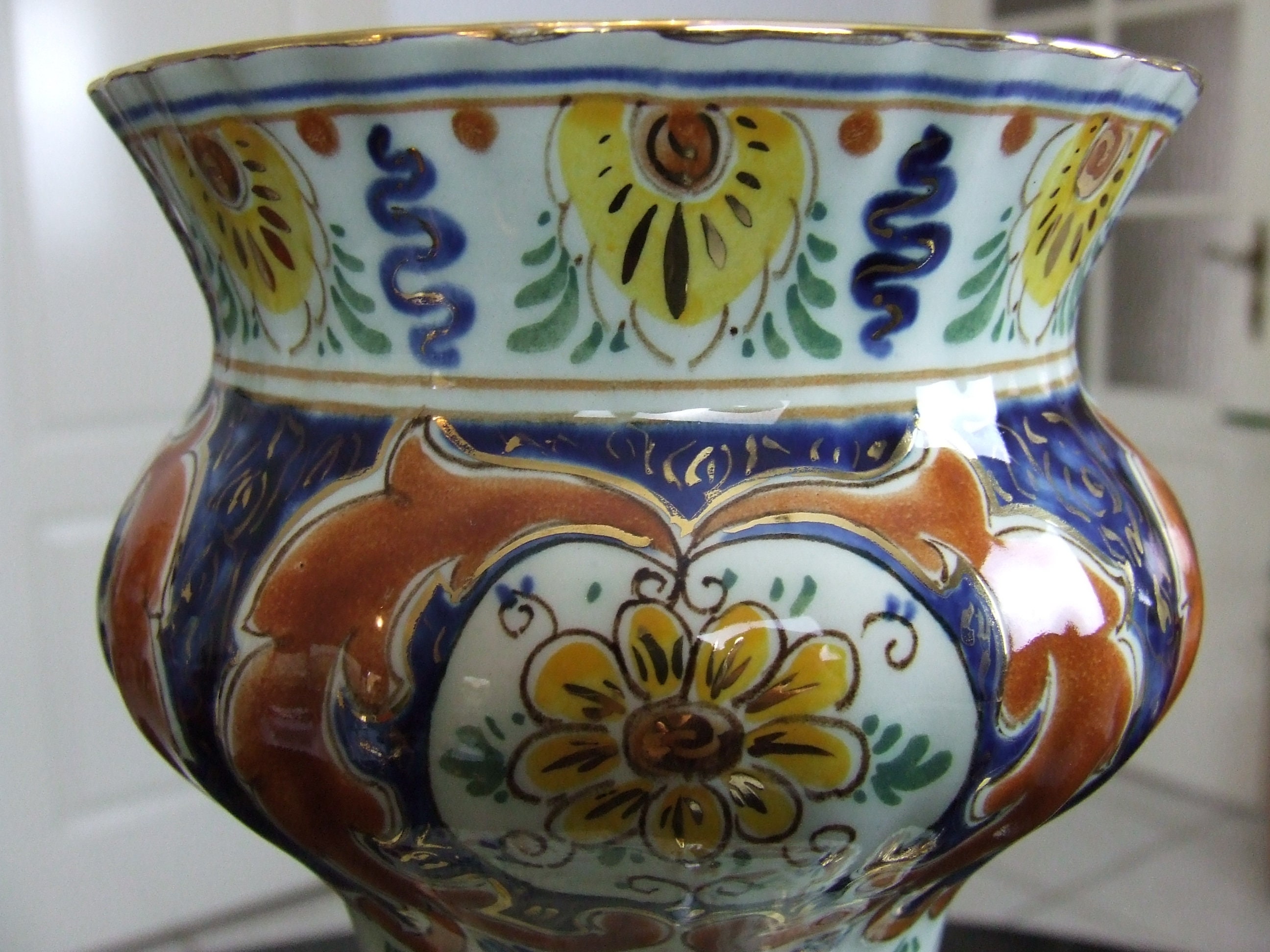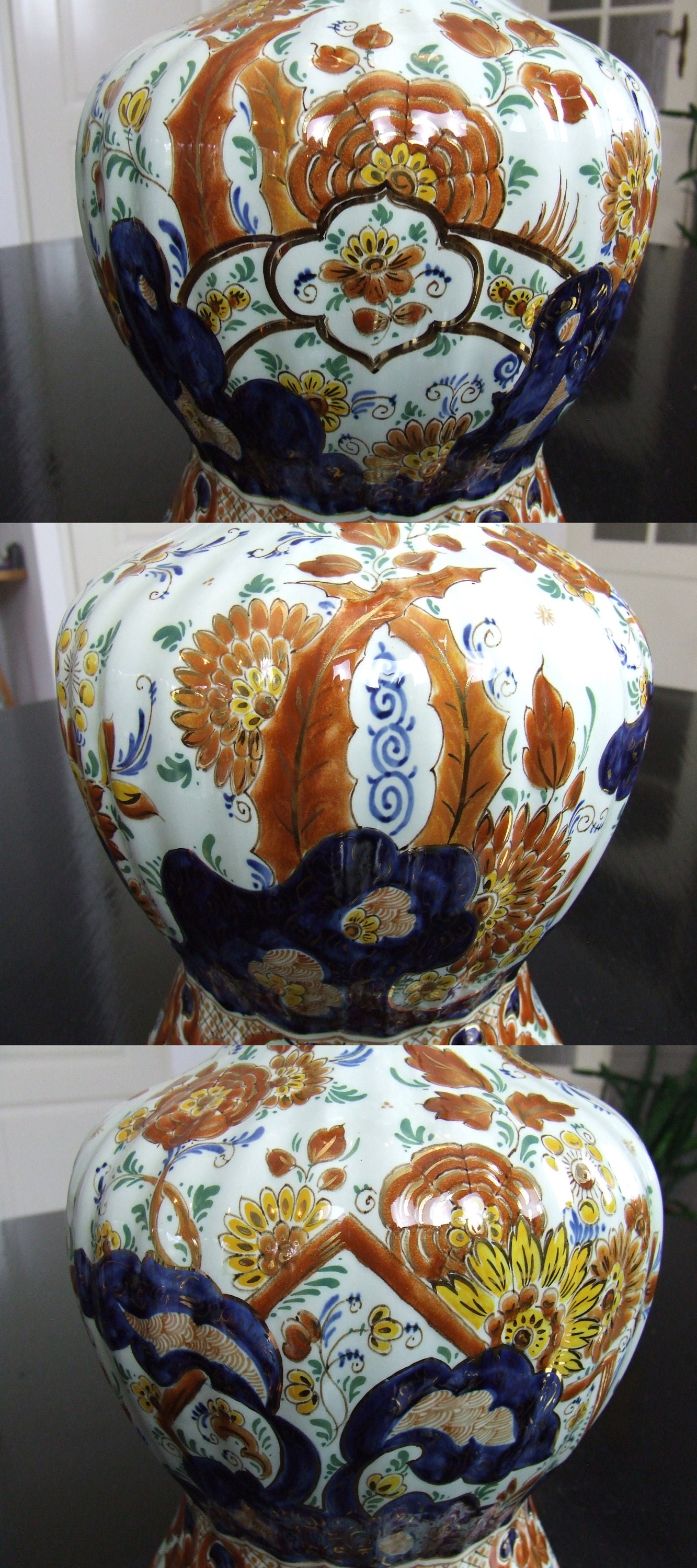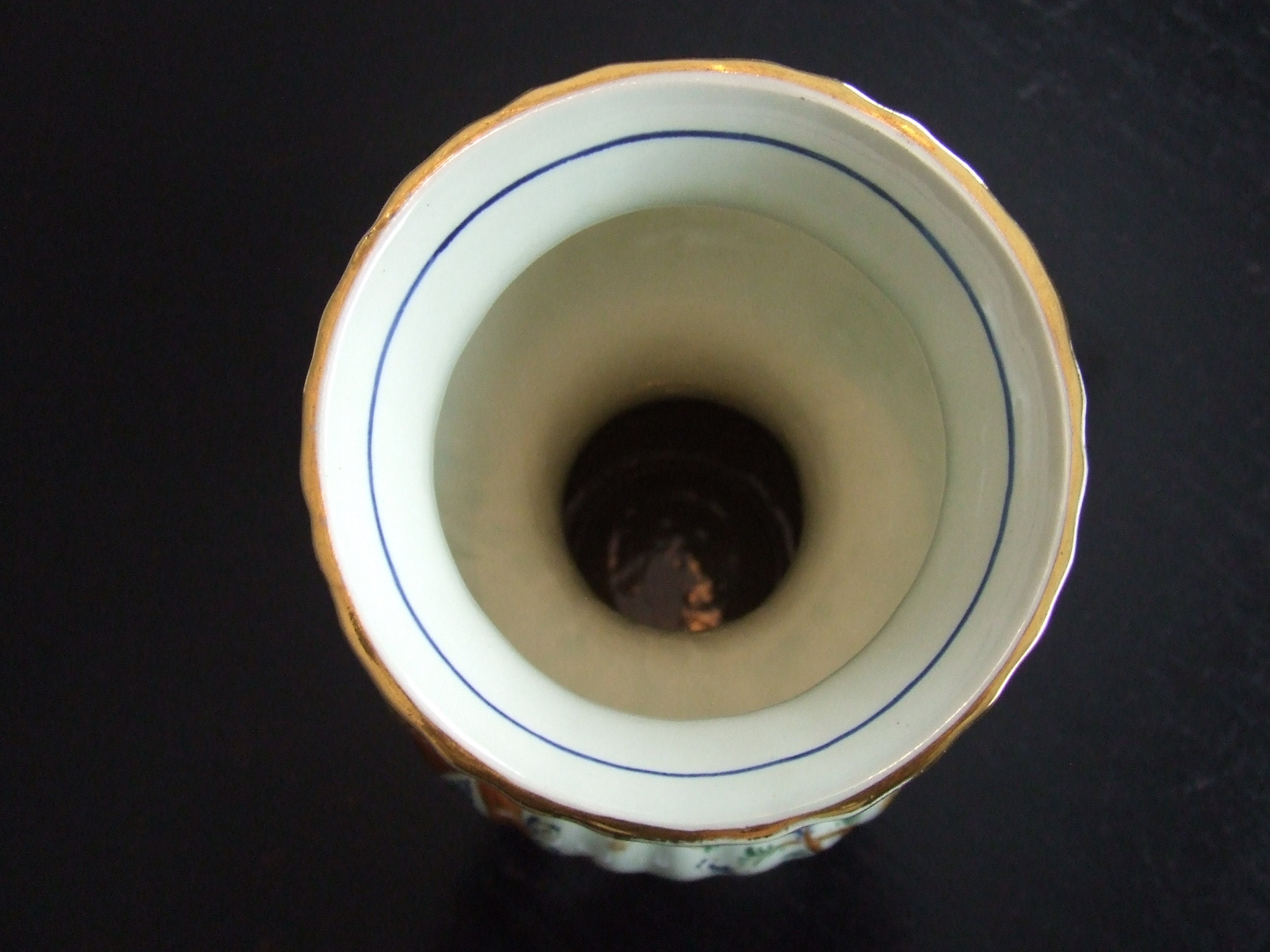Plateelbakkerij Zuid-Holland (PZH) very large handpainted Delft imari 'garlic-neck' vase










Very large (44,5 cm high) handpainted Delft style "garlic-neck" vase (the Dutch name for this type of vase is "knobbelvaas", which translates to "knob vase"), made in the 1950's by Plateelbakkerij Zuid-Holland (PZH) in Gouda, the Netherlands. The vase is painted in Delft imari style (based on the Japanese imari style of ceramics) using blue, green, yellow, brown and gold colours. The blue, green, yellow and brown colours are applied underglaze, while the gold paint is applied overglaze. The body of the vase has a decoration which encircles the vase, showing a fantasy garden with a wide array of flowers, leaves and ribbons. The base of the vase and the knob are decorated with Delft style ornaments. The vase is ribbed, which adds an extra sheen to the glaze. The inside of the vase is fully glazed.
The Delftware of Zuid-Holland is noted for its very good quality, comparable with that of the Porceleyne Fles (Royal Delft). In comparison with the Porceleyne Fles, the decorations of Zuid-Holland are more flamboyant and expressive, which is probably an influence from their Gouda style products, which often feature expressive, organic decorations. The glaze of PZH also has a bit darker tint, which makes it look especially good at night under incandescent light. It has a gloss and sparkle that is really unique for PZH.
The vase is signed at the bottom with a handpainted PZH mark (a house with a gate, the Lazarus gate of Gouda), a vase model number (5054) and the classifications "Delft" and "Holland". To the left of the PZH mark there is a year symbol which we cannot identify, but which could be the year symbol of 1956. To the right of the PZH mark we find the painters signature, "Gv", which is the signature of Mr. Gerrit Nicolaas Veerman, who worked from 1918 till 1964 at PZH as a painter. His mark is often found on Delft style items of PZH from the 1950's. Underneath the PZH mark there is an additional number (4001), which most probably is a batch number.
Condition: excellent, there are no damages, cracks, hairlines or restorations. There is no crazing or visible wear to the glaze, which has a beautiful gloss. The overglaze gold paint has been applied thickly and show very little wear, except for a bit on the edge of the mouth of the vase. The inside of the vase is clean.
Imari style Delftware of Zuid-Holland is quite rare and cannot be often found on the market, certainly not in a large and beautiful shape like this. The flamboyant style and rich colours make this a piece of Delftware that will not easily bore. An exceptional vase, which will add class, style and colour to any room and will match with a variety of interior styles, from classic to modern.
Made by: Plateelbakkerij Zuid-Holland
Place of manufacture: Gouda, the Netherlands
Year of manufacture: most probably between 1950 and 1957
Method of decoration: handpainted (underglaze and overglaze)
Size: height: 42,2 cm, diameter: 21,7 cm (capacity 6 litres)
Weight: 2,52 kg
Additional pictures of the object can be provided if required.
----------------------------------------------------------------------
About Plateelbakkerij Zuid-Holland:
Plateelbakkerij Zuid-Holland (also known as "Plazuid" or PZH) was a pottery company located in the city of Gouda which played a leading role in the development of the Gouda art pottery style during the 1900-1920 period. The factory was founded in 1898 and produced till 1910 primarily high-quality art nouveau / Jugendstil style pottery. In 1909 it developed a matt glaze technique that became characteristic for Gouda style pottery in the following decades (up till then the decoration was often painted underglaze with a high gloss finish). Production was quite successful and around 1920 over 300 people were employed by the company. Many famous names in Dutch ceramic art have created designs for Zuid-Holland.
Decline came when during 1928 a yearlong (!) labour strike of factory workers demanding higher wages struck the Gouda pottery industry. After that was resolved, the Great Depression of the 1930's kicked in. In reaction to this, production became oriented towards more simple designs and techniques and to the production of tableware instead of art pottery. After WWII the factory continued its production. Delftware (Delft Blue and polychrome styles), which had always been produced by the factory alongside its Gouda styles, became more important. The company survived up till 1965, when rising labour costs and competition from other Dutch ceramic factories such as Zenith and Goedewaagen forced a sudden closure.
More information on Plateelbakkerij Zuid-Holland (and Gouda pottery in general) can be found on this English language website: www.goudadesign.co.uk.
----------------------------------------------------------------------
This beautiful piece will be securely packed and send by tracked and insured mail. If you buy multiple items from our shop, we will combine the shipping of these items. If the actual combined shipping costs are less than the shipping costs that you have already paid, we will refund the difference. So you will only pay the actual shipping costs.
If you are not satisfied with your purchase, you may contact us within 14 days from the delivery date to return the item. If the item is returned in its original condition, we will issue a full refund (return costs are however not covered).
Shipping from The Netherlands
Processing time
1-2 business days
Customs and import taxes
Buyers are responsible for any customs and import taxes that may apply. I'm not responsible for delays due to customs.
Payment Options
Returns & Exchanges
I gladly accept returns
Just contact me within: 14 days of delivery
Ship items back to me within: 30 days of delivery
I don't accept exchanges or cancellations
But please contact me if you have any problems with your order.
Conditions of return
Buyers are responsible for return shipping costs. If the item is not returned in its original condition, the buyer is responsible for any loss in value.
Frequently Asked Questions
What are your shipping times?
We will send off your order within one or two working days. We use the standard parcel service of PostNL to ship our parcels. You can find their estimated delivery times per country here (shortened link to pdf download of PostNL): https://bit.ly/3ZHTMJ9. In the fourth column (parcels) you can find the delivery times of the standard service (in estimated business / working days). Please keep in mind that customs / import procedures in non-EU countries can sometimes add an extra week (or even two weeks) to the delivery times.
On request we can also ship with UPS for a faster delivery: expedited (within 10 days) or express (within a few days). There are no customs delays when shipping with UPS. Contact us before the purchase to get a quote.
How do you pack your items, will my item arrive safely?
Broken ceramics is a thing we do not like! Not only is it a waste of time and money, but it also (often) means the end for a rare and unique item, which was treasured and cared for by their previous owners. So we really want to avoid any damages during shipping!
We have lots of experience of shipping ceramics, and we have seen what works and what does not work to protect ceramics during transit. If we ship multiple items in one package, each item is carefully wrapped and kept well seperated from the other items. We use large boxes, with plenty of buffer all around the items, so the packages can withstand a lot of abuse. All our packages should be able to cope with a 1,5 m drop without the items getting damaged.
Do you take care of the environment?
Yes we do. We re-use packaging materials as much as possible, which means we rarely need to buy new materials for our packaging. Only foam peanuts are sometimes bought by us, in which case we prefer to use green starch based peanuts which are fully biodegradable, non-toxic and water-soluble.
Each year, we calculate the greenhouse gas emissions in CO2-equivalents caused by our shipping. We multiply that amount by 200% and then offset it in certified CO2 compensation projects based on tree planting / reforestation in various parts of the world. So far, we have offset 35,5 tonnes of CO2 emissions in projects in Bolivia and Borneo (Indonesia). See https://treesforall.nl/en/projects/ for more information on the projects.
How should I take care of my Dutch ceramics?
First of all, don't let them fall! Always handle them in a mindful way and put them in spots where they cannot be accidentally bumped over when cleaning or vacuuming. Some people put some (clean) sand in vases to make them more stable.
Second, don't clean them too often! Underglaze painted Gouda and Delftware can be perfectly cleaned with water if necessary, but often just dusting them off or polishing them up a bit with a soft dry cloth is enough. Overglaze painted items should not be cleaned too often.
The colours of ceramics do not fade in sunlight, so you can put them in bright spots where they look good. But do avoid large temperature differences, which will cause increased crazing in many Delftware and also Gouda type pieces.